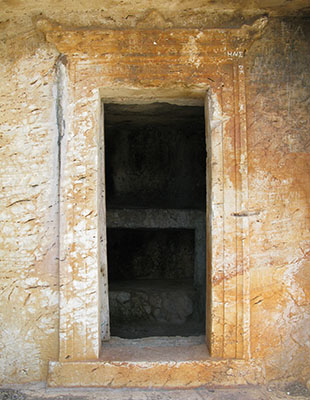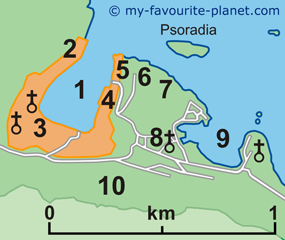|
|
|
| My Favourite Planet > English > Europe > Greece > Dodecanese > Kastellorizo > gallery |
| Kastellorizo, Greece |
Kastellorizo gallery |
 |
 |
181 of 260 |
 |
 |
|
| |

The doorway of the Lycian rock-cut tomb (4th century BC), Kastellorizo. |
| |
The doorway of the tomb was a equipped with a sliding door so that further family members could be interred. The grooves along which the door slid can be seen in the photos on the right. The tomb now has a modern wooden sliding door (presumably closed by somebody at night), though it is much flimsier than the original.
Inside the tomb the deceased were laid on stone benches arranged on two levels around three walls.
Lycian tombs were richly decorated with paintings, reliefs and inscriptions, very few of which have survived centuries of weathering, plunder, vandalism and neglect. Over the years the tombs have been used to house people and animals and for storage. Many of the tombs' interiors have been badly charred by fire. Where the fires lit by past inhabitants for warmth and cooking, or set to deliberately deface the pagan imagery? A lot can happen in 2300 years.
This is the only known Lycian tomb in Greece, and as with most of the others on the Turkish mainland, it is not known exactly when, for whom or by whom it was built. Although the decoration has long vanished, the structure is in very good condition. The red colouring in the limestone, caused by iron in the rock, gives the surface an attractive natural patina. The skill of the craftsmen who carved such tombs from the rockface with such precision using primitive tools is very impressive.
The facade, typical of such tombs, is described as Doric because it resembles the columns and roof of Greek Doric temples. The Lycians were not Greeks and are thought to have been an indigenous Anatolian people with a distinct language and culture. (Other theories include the idea that the area was settled by Minoans from Crete.) They were certainly influenced by Greek architecture and adopted the Greek alphabet, adding six letters of their own. But how much the Greeks and Anatolian peoples influenced each other in matters of agriculture, technology, culture and religion is debatable.
The similarities in style and technique between such Lycian rock-cut architecture and the ancient Nabatean city of Petra (in modern day Jordan), carved out of desert cliffs, are obvious. It is often said that Petra was built by Greeks. But this building technique is not native to Greece, and it is seems more likely that specialists from Lycia were responsible. Greeks conquered Lycia under Alexander the Great in 334 BC (around the time this tomb was built), and it remained Greek until 1923 AD. Petra was built when Greece, much of western Asia and north Africa were under Roman control. Had Greeks taken over the Lycian building skills by this time, or were the indigenous craftsmen still in business? And to what extent did the Greeks and Lycians mix? The search for answers never ends on My Favourite Planet.
| |

Map detail: Kastellorizo harbour
|
1 main harbour of Megisti
2 police station, post office, municipal hotel
3 Agios Georgios church, Nikolaos Stamatiou school, travel agent
4 ferry landing, harbour police, tourist information, bank, duty free
5 coast guard, mosque, path to Lycian tomb
6 Megisti museum, path to Lycian tomb
7 Knight’s Castle, Saints Nicholas & Dimitrios, hamam, windmill
8 Horafia, Platea Panagia, churches, Santrapeia school, Despina sculpture,Taverna Mediterraneo
9 Mandraki harbour and cemetery
10 stairs to clifftop view |
|
| |
Maps, photos and articles: © David John,
except where otherwise specified.
Additional photos: © Konstanze Gundudis
All photos and articles are copyright protected.
Images and materials by other authors
have been attributed where applicable.
Please do not use these photos or articles without permission.
If you are interested in using any of the photos for your website,
project or publication, please get in contact.
Higher resolution versions are available on request.
My Favourite Planet makes great efforts to provide
comprehensive and accurate information across this
website. However, we can take no responsibility for
inaccuracies or changes made by providers of services
mentioned on these pages. |
|
| |
 |
Visit the My Favourite Planet Group on Facebook.
Join the group, write a message or comment,
post photos and videos, start a discussion... |
|
|
| |
|
|
| |
| |
Olive Garden Restaurant
Kastellorizo,
Greece
+30 22460 49 109
kastellorizo.de
|
| |
Papoutsis
Travel Agency
Kastellorizo,
Greece
+30 22460 49 286
greeklodgings.gr
|
| |
 |
| |
 |
| |
 |
| |
 |
| |
 |
| |
 |
| |
George Alvanos
rooms in
Kavala's historic Panagia District
Anthemiou 35,
Kavala, Greece
kavalarooms.gr
|
| |
|